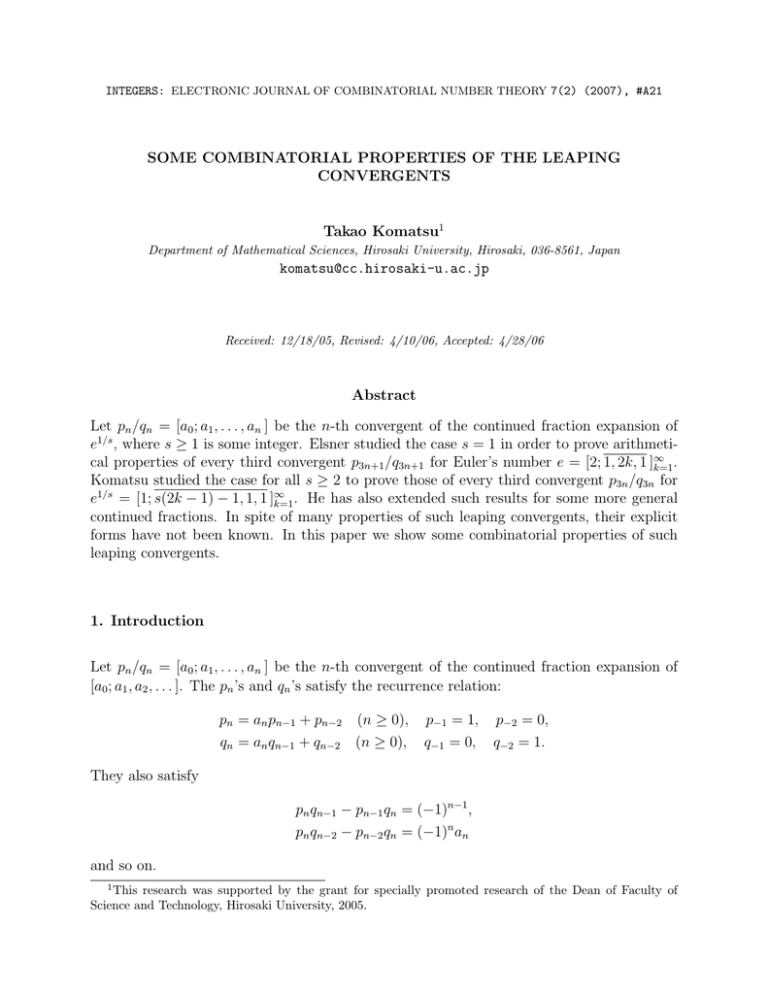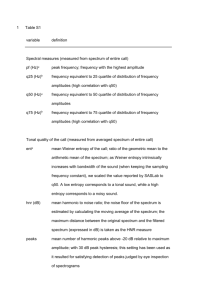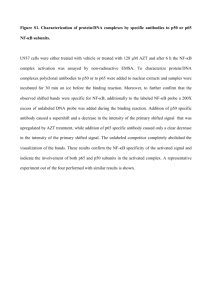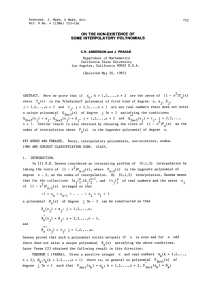SOME COMBINATORIAL PROPERTIES OF THE LEAPING CONVERGENTS Takao Komatsu -u.ac.jp
advertisement

INTEGERS: ELECTRONIC JOURNAL OF COMBINATORIAL NUMBER THEORY 7(2) (2007), #A21 SOME COMBINATORIAL PROPERTIES OF THE LEAPING CONVERGENTS Takao Komatsu1 Department of Mathematical Sciences, Hirosaki University, Hirosaki, 036-8561, Japan komatsu@cc.hirosaki-u.ac.jp Received: 12/18/05, Revised: 4/10/06, Accepted: 4/28/06 Abstract Let pn /qn = [a0 ; a1 , . . . , an ] be the n-th convergent of the continued fraction expansion of e1/s , where s ≥ 1 is some integer. Elsner studied the case s = 1 in order to prove arithmetical properties of every third convergent p3n+1 /q3n+1 for Euler’s number e = [2; 1, 2k, 1 ]∞ k=1 . Komatsu studied the case for all s ≥ 2 to prove those of every third convergent p3n /q3n for e1/s = [1; s(2k − 1) − 1, 1, 1 ]∞ k=1 . He has also extended such results for some more general continued fractions. In spite of many properties of such leaping convergents, their explicit forms have not been known. In this paper we show some combinatorial properties of such leaping convergents. 1. Introduction Let pn /qn = [a0 ; a1 , . . . , an ] be the n-th convergent of the continued fraction expansion of [a0 ; a1 , a2 , . . . ]. The pn ’s and qn ’s satisfy the recurrence relation: pn = an pn−1 + pn−2 (n ≥ 0), qn = an qn−1 + qn−2 (n ≥ 0), p−1 = 1, p−2 = 0, q−1 = 0, q−2 = 1. They also satisfy pn qn−1 − pn−1 qn = (−1)n−1 , pn qn−2 − pn−2 qn = (−1)n an and so on. This research was supported by the grant for specially promoted research of the Dean of Faculty of Science and Technology, Hirosaki University, 2005. 1 INTEGERS: ELECTRONIC JOURNAL OF COMBINATORIAL NUMBER THEORY 7(2) (2007), #A21 2 The number e1/s (s = 1, 2, . . . ) has many significant arithmetical properties. Elsner [1] studied the case s = 1 of Euler’s number e = [2; 1, 2k, 1 ]∞ k=1 , finding that every third convergent also has the similar characteristic relations to the original convergents. Putting Pn = p3n+1 , Qn = q3n+1 (n ≥ 0), P−1 = P−2 = Q−1 = 1, Q−2 = −1, P−n = Pn−3 and Q−n = −Qn−3 (n ≥ 0), then for any integer n, Pn = 2(2n + 1)Pn−1 + Pn−2 , Qn = 2(2n + 1)Qn−1 + Qn−2 , Pn−1 Qn − Pn Qn−1 = 2(−1)n−1 , Pn−2 Qn − Pn Qn−2 = 4(2n + 1)(−1)n and some similar properties. Komatsu [3] studied the cases s ≥ 2 of e1/s = ∞ [1; s(2k − 1) − 1, 1, 1 ]k=1 to find similar properties. Putting Pn = p3n , Qn = q3n (n ≥ 0), P−n = Pn−1 and Q−n = −Qn−1 (n ≥ 0), then for any integer n Pn = 2s(2n − 1)Pn−1 + Pn−2 , Qn = 2s(2n − 1)Qn−1 + Qn−2 , Pn−1 Qn − Pn Qn−1 = 2(−1)n , Pn−2 Qn − Pn Qn−2 = 4s(2n − 1)(−1)n−1 and some more similar properties. Though there are many properties of such leaping convergents, Pn or Qn themselves have not been explicitly known. In this paper we exhibit combinatorially explicit forms of such leaping convergents. Consider the continued fraction expansion of α = [1; ak + b, c, d ]∞ k=1 , where a and b are integers so that every ak + b is a positive integer for k = 1, 2, . . . , and c and d are positive integers. It is known [2, Theorem 1] that if we put Pn = p3n and Qn = q3n (n ≥ 0), then for n ≥ 2 we have the recurrence relations Pn = Sn Pn−1 + Pn−2 , Qn = Sn Qn−1 + Qn−2 , where Sn = (cd + 1)(an + b) + c + d. However, none of P̂n = p3n+1 , Q̂n = q3n+1 , P̃n = p3n+2 and Q̃n = q3n+2 satisfies such recurrence relations. But they satisfy some different types of relation. It is impossible to express pn or qn in a closed form in a general way because 2(an + b + 1) is not constant. Nevertheless, there exist general closed forms about Pn and Qn , and even P̂n , Q̂n , P̃n and Q̃n . 2. Combinatorial Expression of Leaping Convergents As usual, binomial coefficients are defined by n(n−1)...(n−k+1) ! " , k > 0; k! n = 1, k = 0; k 0, k < 0. INTEGERS: ELECTRONIC JOURNAL OF COMBINATORIAL NUMBER THEORY 7(2) (2007), #A21 3 Our main result is the following theorem. For simplicity, put Sn = (cd+1)(an+b)+c+d. As usual, the empty product equals 1. Theorem 1 Let α = [1; ak + b, c, d ]∞ k=1 . Then we have for n ≥ 1 p3n = n #' " n−2k 2$! n−k ( k k=0 p3n−1 = n #' " 2 $ !! n−k−1 k−1 k=0 + n −1 %' 2& k=0 ! "" n−2k ( c(a(k + 1) + b + 1) n − k − 1 + Sk+i Sk+1 k i=1 ! " n−2k−1 n − k − 1 −1 ( (Sn−k − a(n − 2k − 1)) Sk+1 Sk+i , k i=1 %' &−1 ! " n−2k−1 ( n−k−1 = (a(k + 1) + b + 1) Sk+i+1 k i=1 k=0 n 2 p3n−2 i=1 n −1 ! %' " n−2k−1 2& ( n−k−1 Sk+i + (cd − c + 1) Sk+i+1 , k i=1 k=0 n −1 #' ! " n−2k−2 2$ ( n−k−2 + ((n − k − 1)ad − d + 1) Sk+i+1 k i=1 k=0 and q3n = n #' " n−2k 2$! n−k ( k k=0 i=1 %' &−1 ! " n−2k−1 ( n−k−1 = (c(a(k + 1) + b) + 1) Sk+i+1 k i=1 k=0 n 2 q3n−1 n −1 ! %' " n−2k−1 2& ( n−k−1 Sk+i − c Sk+i+1 , k i=1 k=0 n −1 #' ! " n−2k−2 2$ ( n−k−2 −a (n − k − 1) Sk+i+1 , k i=1 k=0 q3n−2 = n #' " 2 $ !! n−k−1 k−1 k=0 − n −1 %' 2& k=0 ! "" n−2k ( a(k + 1) + b + c n − k − 1 + Sk+i Sk+1 k i=1 ! " n−2k−1 n − k − 1 −1 ( (cSn−k − ad(n − 2k − 1)) Sk+1 Sk+i . k i=1 The 0-th convergent 1 may not be so important and some expressions may be awkward for this result. However, putting c = d = 1 in Theorem 1, we have the following corresponding results between the p’s and q’s. INTEGERS: ELECTRONIC JOURNAL OF COMBINATORIAL NUMBER THEORY 7(2) (2007), #A21 Corollary 1 Let α = [1; ak + b, 1, 1 ]∞ k=1 . Then we have, for n ≥ 1, p3n = n #' 2$ ! " n−2k n−k ( (a(k + i) + b + 1) k i=1 n−2k 2 k=0 + n −1 %' 2& n−2k−1 2 k=0 p3n−1 = n #' 2$ n−2k−1 2 k=0 ! " n−2k−1 ( n−k−1 (a(k + i + 1) + b + 1), k i=1 !! " ! "" n−2k ( n−k n−k−1 + (a(k + i) + b + 1) k k−1 i=1 + (a(n + 1) + 2(b + 1)) n −1 %' 2& n−2k−2 2 k=0 %' n 2 p3n−2 = &−1 n−2k−1 2 k=0 n −1 #' 2$ +a ! " n−2k−2 ( n−k−1 (a(k + i + 1) + b + 1), k i=1 ! " n−2k n−k−1 ( (a(k + i) + b + 1) k i=1 n−2k−2 2 k=0 ! " n−2k−2 ( n−k−2 (n − k − 1) (a(k + i + 1) + b + 1) k i=1 and q3n = n #' 2$ n−2k 2 k=0 − q3n−1 = n −1 %' 2& ! " n−2k n−k ( (a(k + i) + b + 1) k i=1 n−2k−1 2 k=0 n −1 %' 2& n−2k−1 2 k=0 −a #'$ n 2 q3n−2 = k=0 n −1 #' 2$ ! " n−2k n−k−1 ( (a(k + i) + b + 1) k i=1 n−2k−2 2 k=0 n−2k−1 2 ! " n−2k−1 ( n−k−1 (a(k + i + 1) + b + 1), k i=1 ! " n−2k−2 ( n−k−2 (n − k − 1) (a(k + i + 1) + b + 1), k i=1 !! " ! "" n−2k ( n−k n−k−1 + (a(k + i) + b + 1) k k−1 i=1 − (a(n + 1) + 2(b + 1)) n −1 %' 2& k=0 n−2k−2 2 ! " n−2k−2 ( n−k−1 (a(k + i + 1) + b + 1). k i=1 4 INTEGERS: ELECTRONIC JOURNAL OF COMBINATORIAL NUMBER THEORY 7(2) (2007), #A21 5 3. Examples Put a = 2s and b = −s − 1 in Corollary 1. Then we have the continued fraction expansion e1/s = [1; s(2k − 1) − 1, 1, 1]∞ k=1 (s ≥ 2). Let pn /qn be its n-th convergent. In addition, let p∗n /qn∗ be the n-th convergent of the continued fraction expansion of e = [2; 1, 2k, 1]∞ k=1 . Then, for n ≥ 1, we have p3n = p∗3n−2 p3n−1 = p∗3n−3 p3n−2 = p∗3n−4 n ' (2n − k)! n−k = s , k!(n − k)! k=0 =n = n ' (2n − k − 1)! k=0 n−1 ' k=0 k!(n − k)! q3n = n−k s (2n − k − 1)! n−k s , k!(n − k − 1)! , ∗ q3n−2 n ' (2n − k)! n−k = (−1)k s , k!(n − k)! k=0 q3n−1 = q3n−2 = ∗ q3n−3 ∗ q3n−4 n−1 ' (2n − k − 1)! n−k = (−1)k s , k!(n − k − 1)! k=0 n ' (2n − k − 1)! n−k =n (−1)k s . k!(n − k)! k=0 ∗ ∗ ∗ Note that all the six formulas for p∗3n−2 , p∗3n−3 , p∗3n−4 , q3n−2 , q3n−3 and q3n−4 correspond to s = 1 in the continued fraction expansion of e. Put a = c = d = 0 and b = 1 in Theorem 1. Then by Sn = 1 we have Qn = n #' " 2$! n−k k=0 k . In fact, Qn = Fn+1 (n ≥ 0), where Fn is the n-th Fibonacci number (see, e.g., [4, Theorem 12.4]). This is equivalent to the fact that the denominator of the n-th convergent of [1; 1, 1, 1, . . . ] = [1; 1, 0, 0 ] corresponds to Fn . 4. Proof of Theorem 1 We shall prove the results involving the q’s by showing that the three recurrence relations q3n = dq3n−1 + q3n−2 q3n+1 = (a(n + 1) + b)q3n + q3n−1 q3n+2 = cq3n+1 + q3n are valid, provided that the identities from the theorem for the q’s on the right sides are valid. Proof involving the p’s can be done similarly. Note the addition formula ! " ! " ! " m m m+1 + = (l : integer) l l−1 l and the symmetry identity ! " ! " m m = (m ≥ 0, l : integers) . l m−l INTEGERS: ELECTRONIC JOURNAL OF COMBINATORIAL NUMBER THEORY 7(2) (2007), #A21 6 For simplicity, put K = a(k + 1) + b. It is easy to see that q0 = 1, q1 = a + b and q2 = c(a + b) + 1. Suppose that the identities for q3n−2 and q3n−1 are valid for a positive integer n. Then we shall prove that q3n = dq3n−1 + q3n−2 . This follows from ! " ! " n−k−1 n−k−2 d · (cK + 1) Sk+2 · · · Sn−k − d · a(n − k − 1) Sk+2 · · · Sn−k−1 k k ! " ! " n−k−1 n−k−1 + Sk+1 · · · Sn−k + (K + c) Sk+2 · · · Sn−k k−1 k ! " ! " n−k−1 n−k−1 −c Sk+2 · · · Sn−k + ad(n − 2k − 1) Sk+2 · · · Sn−k−1 k k ! " ! " n−k−1 n−k−1 = Sk+1 · · · Sn−k + Sk+1 · · · Sn−k k k−1 ! " n−k−1 −c Sk+2 · · · Sn−k k ! " ! " n−k n−k−1 = Sk+1 · · · Sn−k − c Sk+2 · · · Sn−k . k k )n* +n−k−1, To see this, notice that if n is odd, then for k = − 1 we have ad(n − 2k − 1) = 0. 2 k -n. If n is even, then for k = 2 we have !! " ! "" n−2k ! " n−2k ( n−k−1 a(k + 1) + b + c n − k − 1 n−k ( + Sk+i = Sk+i = 1 . k−1 Sk+1 k k i=1 i=1 Hence, we have the relation q3n = dq3n−1 + q3n−2 . Suppose that the identities for q3n−1 and q3n are valid for a positive integer n. We shall prove that q3n+1 = (a(n + 1) + b)q3n + q3n−1 . We can see that (a(n + 1) + b) n #' " n−2k 2$! n−k ( k=0 k i=1 Sk+i n n #' #' ! " n−2k+1 " n−2k 2$ 2$ ! ( K n−k n−k ( = Sk+i + a k Sk+i Sk+1 k k i=1 k=0 + n #' 2$ k=0 n 2 i=1 k=0 ! " n−2k n − k −1 ( a(c + d)(n − 2k) Sk+1 Sk+i k i=1 #'$ ! " n−2k+1 ( K n−k = Sk+i Sk+1 k i=1 k=0 n 2 #' $−1 ! " n−2k−2 ( n−k−2 +a (n − k − 1) Sk+i+1 k k=0 n 2 + #'$ k=0 + i=1 ! " n−2k n − k − 1 −1 ( ca(n − k) Sk+1 Sk+i k n−1 %' 2 & k=0 i=1 ! " n−2k n − k −1 ( ad(n − 2k) Sk+1 Sk+i k i=1 INTEGERS: ELECTRONIC JOURNAL OF COMBINATORIAL NUMBER THEORY 7(2) (2007), #A21 7 and n n −1 ! −1 %' %' " n−2k−1 ! " n−2k−1 2& 2& ( ( n−k−1 n−k−1 − (a(n + 1) + b)c Sk+i+1 + (cK + 1) Sk+i+1 k k i=1 k=0 =− n −1 %' 2& k=0 i=1 k=0 n+1 #' ! " n−2k−1 " n−2k+1 2 $! ( ( n−k−1 n−k ca(n − k) Sk+i+1 + Sk+i . k k−1 i=1 k=0 i=1 Hence, if n is odd, then (a(n + 1) + b)q3n + q3n−1 = n+1 #' " n−2k+1 2 $! ( n−k k=0 k−1 %'& n−1 2 + k=0 i=1 n #' ! " n−2k+1 2$ ( K n−k Sk+i + Sk+i Sk+1 k i=1 k=0 ! " n−2k n − k −1 ( ad(n − 2k) Sk+1 Sk+i k i=1 = q3n+1 , + , . + , - . since K n−k = 0 for k = n+1 . If n is even, then by ca(n − k) n−k−1 = 0 for k = n2 , in k 2 k a similar way we obtain (a(n + 1) + b)q3n + q3n−1 = q3n+1 . Suppose that the identities for q3n and q3n+1 are valid for a positive integer n. Then we shall prove that q3n+2 = cq3n+1 + q3n . Since c n+1 #' " 2 $ !! n−k k=0 n #' ! "" n−2k+1 " n−2k 2$! ( K n−k n−k ( + Sk+i + Sk+i k−1 Sk+1 k k i=1 i=1 k=0 n+1 −1 ! # n+1 #' " n−2k−1 ! " n−2k 2 $ 2 $ ' ( n−k−1 n−k ( = c Sk+i+1 + cK Sk+i+1 k k i=1 i=1 k=0 k=0 n −1 ! % n+1 #' " n−2k ! " n−2k−1 2 & 2$ ' ( ( n−k n−k + Sk+i+1 − (cd + 1)a(n − 2k) Sk+i+1 k k i=1 i=1 k=0 k=0 and c −1 % n+1 2 & ' k=0 n #' 2$ n −1 ! %' ! " n−2k−1 " n−2k−1 2& ( ( n−k n−k−1 ad(n − 2k) Sk+i+1 − c Sk+i+1 k k i=1 i=1 k=0 −1 ! # n+1 ! " n−2k−1 " n−2k−1 2 $ ( ' ( n−k n−k−1 = cd a(n − 2k) Sk+i+1 − c Sk+i+1 , k k i=1 i=1 k=0 k=0 we have cq3n+1 + q3n = q3n+2 . Notice that if n is odd, then cK + , -n. is even, then (cd + 1)a(n − 2k) n−k = 0 for k = . k 2 +n−k, k = 0 for k = - n+1 . ; if n 2 INTEGERS: ELECTRONIC JOURNAL OF COMBINATORIAL NUMBER THEORY 7(2) (2007), #A21 8 5. Some More Recurrence Relations We start by remarking that P̂n = p3n+1 , Q̂n = q3n+1 , P̃n = p3n+2 and Q̃n = q3n+2 do not satisfy any recurrence relations of the type Pn = Sn Pn−1 + Pn−2 . They do, however, satisfy some different types of relations. In fact, such relations also hold for a more general continued fraction of [1; T1 (k), T2 (k), T3 (k)]∞ k=1 . Theorem 2 Let α = [1; T1 (k), T2 (k), T3 (k) ]∞ k=1 , where each Ti (k) (i = 1, 2, 3) takes a positive integer for k = 1, 2, . . . . Then for every integer n ≥ 2 we have (T3 (n − 1)T1 (n) + 1)p3n+1 = U (n)p3n−2 + (T3 (n)T1 (n + 1) + 1)p3n−5 , (T3 (n − 1)T1 (n) + 1)q3n+1 = U (n)q3n−2 + (T3 (n)T1 (n + 1) + 1)q3n−5 , where U (n) = (T3 (n−1)T1 (n)+1)((T2 (n)T3 (n)+1)T1 (n+1)+T2 (n))+T3 (n−1)(T3 (n)T1 (n+ 1) + 1), and (T1 (n)T2 (n) + 1)p3n+2 = V (n)p3n−1 + (T1 (n + 1)T2 (n + 1) + 1)p3n−4 , (T1 (n)T2 (n) + 1)q3n+2 = V (n)q3n−1 + (T1 (n + 1)T2 (n + 1) + 1)q3n−4 , where V (n) = (T1 (n)T2 (n) + 1)(T3 (n)(T1 (n + 1)T2 (n + 1) + 1) + T2 (n + 1)) + T1 (n)(T1 (n + 1)T2 (n + 1) + 1). Remark. If T1 (n) = an + b, T2 (n) = c, and T3 (n) = d, then U (n) = a2 d(cd + 1)n2 + a((a + 2b)d(cd + 1) + d2 + 2cd + 1)n + b(a + b)d(cd + 1) + a(d2 + cd + 1) + b(d2 + 2cd + 1) + c + d , U (n + 1) = a2 d(cd + 1)n2 + a((3a + 2b)d(cd + 1) + d2 + 2cd + 1)n + (a + b)(2a + b)d(cd + 1) + a(2d2 + 3cd + 2) + b(d2 + 2cd + 1) + c + d , V (n) = a2 c(cd + 1)n2 + a((a + 2b)c(cd + 1) + c2 + 2cd + 1)n + b(a + b)c(cd + 1) + acd + b(c2 + 2cd + 1) + c + d , V (n + 1) = a2 c(cd + 1)n2 + a((3a + 2b)c(cd + 1) + c2 + 2cd + 1)n + (a + b)(2a + b)c(cd + 1) + a(c2 + 3cd + 1) + b(c2 + 2cd + 1) + c + d . Proof of Theorem 2. Since ! " ! "! "! "! " p3n+1 p3n p3n−2 p3n−3 T2 (n) 1 T3 (n) 1 T1 (n + 1) 1 = , q3n+1 q3n q3n−2 q3n−3 1 0 1 0 1 0 by comparing the (1, 1) element, we have p3n+1 = ((T2 (n)T3 (n) + 1)T1 (n + 1) + T2 (n))p3n−2 + (T3 (n)T( n + 1) + 1)p3n−3 . The identity involving the q’s is similar and omitted. (1) 9 INTEGERS: ELECTRONIC JOURNAL OF COMBINATORIAL NUMBER THEORY 7(2) (2007), #A21 Since ! p3n−2 q3n−2 ! p3n−5 = q3n−5 p3n−3 q3n−3 p3n−6 q3n−6 " = "! ! p3n−5 p3n−6 q3n−5 q3n−6 "! T2 (n − 1) 1 1 0 "! T3 (n − 1) 1 1 0 "! T1 (n) 1 1 0 " (T2 (n − 1)T3 (n − 1) + 1)T1 (n) + T2 (n − 1) T2 (n − 1)T3 (n − 1) + 1 T3 (n − 1)T1 (n) + 1 T3 (n − 1) " by ! = ! p3n−5 p3n−6 q3n−5 q3n−6 p3n−2 p3n−3 q3n−2 q3n−3 " "! −T3 (n − 1) T2 (n − 1)T3 (n − 1) + 1 T3 (n − 1)T1 (n) + 1 −(T2 (n − 1)T3 (n − 1) + 1)T1 (n) − T2 (n − 1) " we have p3n−5 = −T3 (n − 1)p3n−2 + (T3 (n − 1)T1 (n) + 1)p3n−3 . (2) Substituting (1) and (2) into (T3 (n − 1)T1 (n) + 1)p3n+1 = U (n)p3n−2 + (T3 (n)T1 (n + 1) + 1)p3n−5 and comparing the coefficient of p3n−2 , we get U (n) = (T3 (n − 1)T1 (n) + 1)((T2 (n)T3 (n) + 1)T1 (n + 1) + T2 (n)) + T3 (n − 1)(T3 (n)T1 (n + 1) + 1). Notice that the coefficient of p3n−3 is cancelled. In a similar manner, substituting p3n+2 = (T3 (n)(T1 (n + 1)T2 (n + 1) + 1) + T2 (n + 1))p3n−1 + (T1 (n + 1)T (n + 2) + 1)p3n−2 and p3n−4 = −T1 (n)p3n−1 + (T1 (n)T2 (n) + 1)p3n−2 into (T1 (n)T2 (n) + 1)p3n+2 = V (n)p3n−1 + (T1 (n + 1)T2 (n + 1) + 1)p3n−4 and comparing the coefficient of p3n−1 , we get V (n) = (T1 (n)T2 (n) + 1)(T3 (n)(T1 (n + 1)T2 (n + 1) + 1) + T2 (n + 1)) + T1 (n)(T1 (n + 1)T2 (n + 1) + 1). Comments. A further generalization on the leaping convergent was mentioned in [2]. It seems possible to obtain the explicit forms for [1; T (k), c, d ]∞ k=1 in Theorem 1, ∞ [1; T1 (k), T2 (k), T3 (k), T4 (k), T5 (k) ]k=1 in Theorems 1 and 2, and so on. Unfortunately, for /# n2 $ +n−k, 0n−2k /% n2 &−1 +n−k−1, 0n−2k−1 example q3n = k=0 S − c Sk+i+1 does not hold if k+i k=0 i=1 i=1 k k the general T (k) replaces ak + b with Sn = (cd + 1)T (n) + c + d in Theorem 1. We are currently preparing such results. Acknowledgement. This work was initiated when Professor Carsten Elsner visited Hirosaki University in September 2005. The author thanks him for his support by calculation and his useful suggestions in the earlier draft. , , INTEGERS: ELECTRONIC JOURNAL OF COMBINATORIAL NUMBER THEORY 7(2) (2007), #A21 10 References [1] C. Elsner, On arithmetic properties of the convergents of Euler’s number, Colloq. Math. 79 (1999), 133–145. [2] T. Komatsu, Recurrence relations of the leaping convergents, JP Jour. Algebra, Number Theory & Appl. 3 (2003), 447–459. [3] T. Komatsu, Arithmetical properties of the leaping convergents of e1/s , Tokyo J. Math. 27 (2004), 1–12. [4] T. Koshy, Fibonacci and Lucas numbers with applications, Wiley, New York, 2001.









